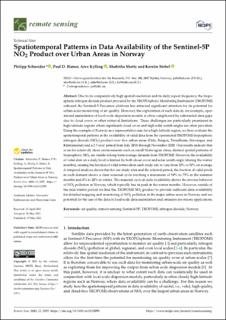| dc.contributor.author | Schneider, Philipp | |
| dc.contributor.author | Hamer, Paul David | |
| dc.contributor.author | Kylling, Arve | |
| dc.contributor.author | Shetty, Shobitha | |
| dc.contributor.author | Stebel, Kerstin | |
| dc.date.accessioned | 2021-06-07T11:30:37Z | |
| dc.date.available | 2021-06-07T11:30:37Z | |
| dc.date.created | 2021-05-31T11:16:42Z | |
| dc.date.issued | 2021 | |
| dc.identifier.citation | Remote Sensing. 2021, 13, 2095. | en_US |
| dc.identifier.issn | 2072-4292 | |
| dc.identifier.uri | https://hdl.handle.net/11250/2758195 | |
| dc.description.abstract | Due to its comparatively high spatial resolution and its daily repeat frequency, the tropospheric nitrogen dioxide product provided by the TROPOspheric Monitoring Instrument (TROPOMI) onboard the Sentinel-5 Precursor platform has attracted significant attention for its potential for urban-scale monitoring of air quality. However, the exploitation of such data in, for example, operational assimilation of local-scale dispersion models is often complicated by substantial data gaps due to cloud cover or other retrieval limitations. These challenges are particularly prominent in high-latitude regions where significant cloud cover and high solar zenith angles are often prevalent. Using the example of Norway as a representative case for a high-latitude region, we here evaluate the spatiotemporal patterns in the availability of valid data from the operational TROPOMI tropospheric nitrogen dioxide (NO2) product over five urban areas (Oslo, Bergen, Trondheim, Stavanger, and Kristiansand) and a 2.5 year period from July 2018 through November 2020. Our results indicate that even for relatively clean environments such as small Norwegian cities, distinct spatial patterns of tropospheric NO2 are visible in long-term average datasets from TROPOMI. However, the availability of valid data on a daily level is limited by both cloud cover and solar zenith angle (during the winter months), causing the fraction of valid retrievals in each study site to vary from 20% to 50% on average. A temporal analysis shows that for our study sites and the selected period, the fraction of valid pixels in each domain shows a clear seasonal cycle reaching a maximum of 50% to 75% in the summer months and 0% to 20% in winter. The seasonal cycle in data availability shows the inverse behavior of NO2 pollution in Norway, which typically has its peak in the winter months. However, outside of the mid-winter period we find the TROPOMI NO2 product to provide sufficient data availability for detailed mapping and monitoring of NO2 pollution in the major urban areas in Norway and see potential for the use of the data in local-scale data assimilation and emission inversions applications. | en_US |
| dc.language.iso | eng | en_US |
| dc.rights | Navngivelse 4.0 Internasjonal | * |
| dc.rights.uri | http://creativecommons.org/licenses/by/4.0/deed.no | * |
| dc.title | Spatiotemporal Patterns in Data Availability of the Sentinel-5P NO2 Product over Urban Areas in Norway | en_US |
| dc.type | Peer reviewed | en_US |
| dc.type | Journal article | en_US |
| dc.description.version | publishedVersion | en_US |
| dc.rights.holder | © 2021 by the authors. Licensee MDPI, Basel, Switzerland. | en_US |
| dc.source.volume | 13 | en_US |
| dc.source.journal | Remote Sensing | en_US |
| dc.identifier.doi | 10.3390/rs13112095 | |
| dc.identifier.cristin | 1912782 | |
| dc.relation.project | NILU - Norsk institutt for luftforskning: 117011 | en_US |
| dc.relation.project | Norsk romsenter: NIT.05.16.5 | en_US |
| dc.source.articlenumber | 2095 | en_US |
| cristin.ispublished | true | |
| cristin.fulltext | original | |
| cristin.qualitycode | 1 | |

